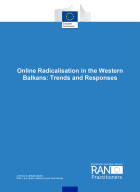Details
- Publication date
- 29 August 2023
- Author
- Directorate-General for Migration and Home Affairs
- RAN Publications Topic
- Internet and radicalisation
Description
The digital revolution has transformed society. While many of these changes have been positive, they have also offered terrorists and extremist groups new access points to amplify and spread their messages and solicit support for their political agenda. To better understand this threat, defining the two concepts is necessary. The internet is a global system of connected computers that allows users to share information and communicate with each other. While the internet has different dimensions, this paper will focus on all communications, activity and content that take place and are stored on the world wide web and cloud structures, including social media networks.
Information and communications technologies refer to all devices, networking components and applications that allow people access to the digital world. Over time, ICTs have become more mobile and affordable, allowing easier access to the internet. According to Datareportal, at the start of 2022 the number of internet users reached 4.95 billion, with an internet penetration rate of 62.5 % globally. Not only have these advancements enabled terrorists and extremist groups to collaborate and communicate more easily among themselves, they have also given them a tool to reach large audiences to influence through propaganda in support of their goals.
Researchers, policymakers and practitioners have raised alarms about this potential threat and the devastating impact it could have on peace and stability. Governments globally, including the EU and its Member States, have taken this perceived threat seriously and have made substantial efforts to prevent and counter terrorist misuse of the internet. However, this phenomenon is broad and complex, requiring holistic approaches. This paper hopes to help inform a response, by helping practitioners understand and address online radicalisation as a part of broader preventing and countering violent extremism (P/CVE) efforts.
Online radicalisation is a term commonly used by stakeholders in the P/CVE field to denote extremist risks and threats emanating from the internet, but it does not have a commonly agreed definition. The EU’s 2020 Counter-Terrorism Agenda and its Regulation 2021/784 on addressing the dissemination of terrorist content online recognise and emphasise the dangers of radicalisation on the internet, but they do not define the concept of online radicalisation. To fill this gap, this paper draws from definitions from non-EU policy and academia.
A United States (US) Department of Justice Community Oriented Policing Services brief defines online extremism to violence as a process by which an individual is introduced to ideological messages and a belief system that encourages movement from mainstream beliefs toward extreme views, primarily through the use of online media, including social networks. Similarly, Adam Bermingham et al. define online radicalisation as a process whereby individuals through online interactions and exposure start to view violence as a legitimate method to achieve political goals and solve conflict.
Although it may seem straightforward, this process is highly dynamic, complex, and difficult to monitor and measure. While separate, online radicalisation is also very closely connected with the processes of recruitment and mobilisation to hate and extremist-motivated violence, which further complicates our understanding of this issue and its consequences for peace and security. While it is generally agreed that the internet plays a role in the radicalisation of individuals, there is limited evidence to comprehensively assess its impact. Despite this, researchers have made headway by mapping online networks, identifying key narratives and assessing dissemination methods. Although most of this work is focused on the supply side of extremist content and actors online, there is enlightening research into demand-side dynamics that have helped stakeholders design and deliver evidence-based responses.
This paper will provide an overview of online radicalisation trends and responses in the Western Balkans, including key narratives, actors, networks and online dissemination strategies, as well as relevant practices to address vulnerabilities and recommendations for practitioners. Before delving into Western Balkansspecific trends, the paper will provide context on the influence of the online space on radicalisation by looking at the opportunities it offers and dispelling some common myths.
Next it will contextualise the Western Balkans within the global landscape of online extremism and hate, pointing out global influences on online extremist activities and content in the Western Balkans, and vice versa to see how the Western Balkans has influenced global online discourses. The paper will then examine key trends, narratives and malign networks pertinent solely to the Western Balkans, paying particular attention to messaging of (violent) right-wing and Islamist extremist groups on the regional and country levels. In this regard, special attention will be put on gender-relevant extremist messaging.
Finally, the paper will introduce prominent responses to this threat and provide recommendations for relevant stakeholders in the region and more broadly. To do this, the paper relies on examining primary sources of data including government-issued regulations and strategies, and secondary literature produced by researchers in the Western Balkans and more broadly across the world.

